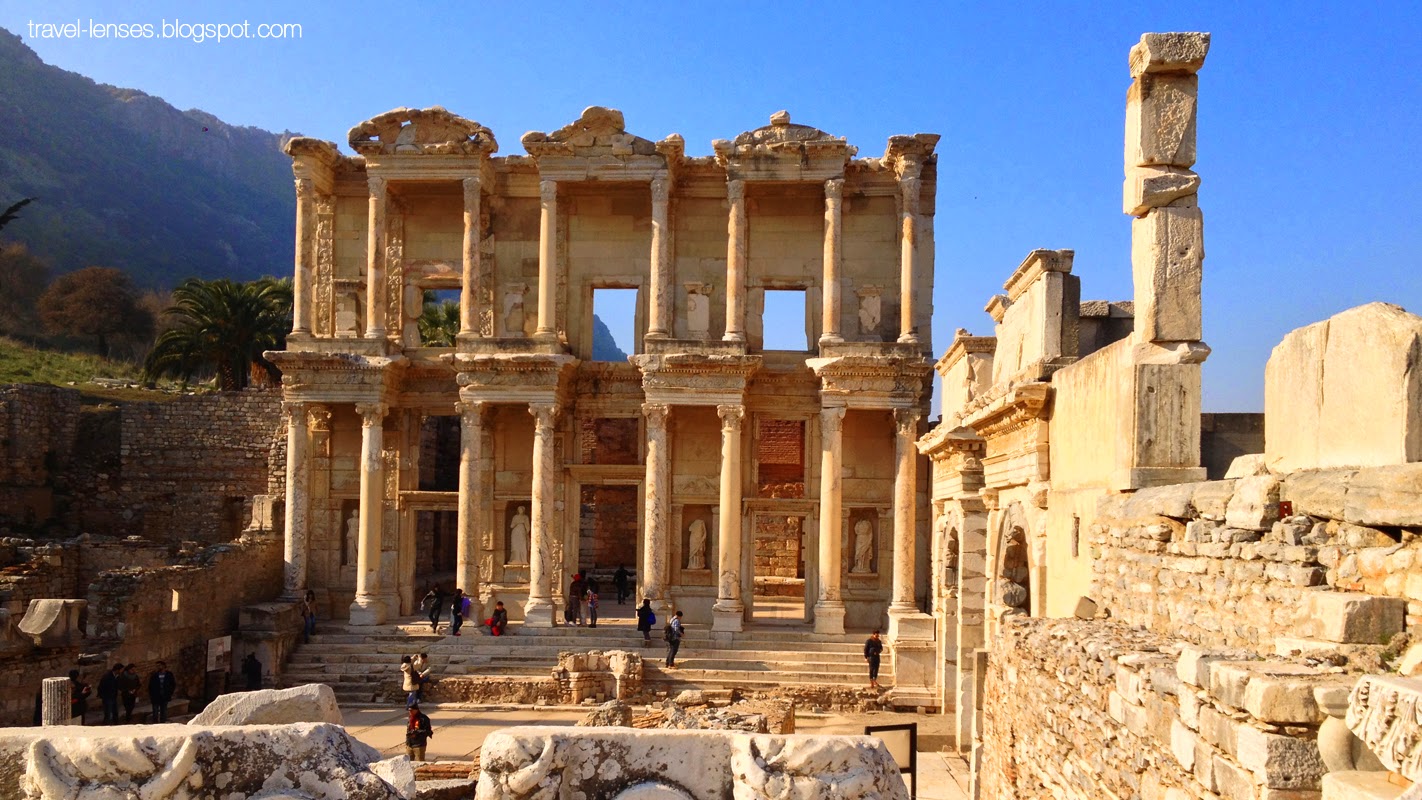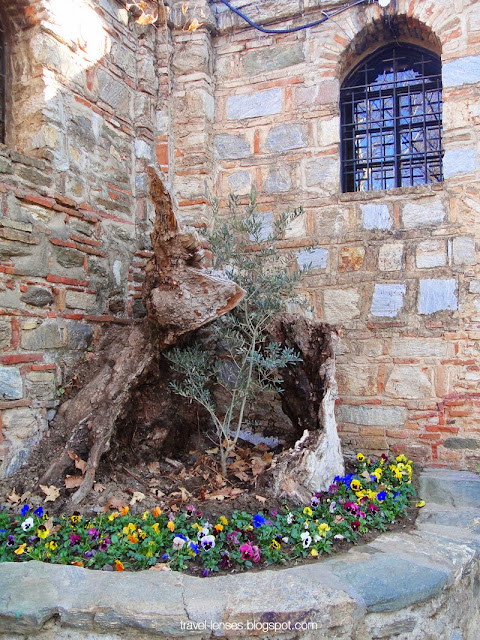[EU Holidays] Turkey Day 3 - Kusadasi
20 December 2013Our tour of Kusadasi began with catching the sunrise and townscape from some high point,
Next was a visit to a leather jacket factory outlet.
Unlike the usual boring shopping outlet visits that plague package tours, this one is special. We were treated to a fashion show with Turkish hunks and babes strutting down the runway donning trendy (and reversible) jackets.
Members of the tour group were also roped into the showcase. But considering the climate in Singapore, they were pretty much barking up the wrong tree.
Our next stop was the Cave of the Seven Sleepers.
According to legend, seven young men who were devout Christians sought refuge in a cave to escape persecution from the Roman ruler. They fell asleep in the cave, waking up only 200 years later to an Ephesus where Christianity was accepted.
When the seven sleepers died, they were buried in the same cave, over which a church was erected.
We ascended a hilly terrain to reach the excavated area where several brick arches of the church remain.
We continued our excursion to sacred destinations to the House of Virgin Mary. Along the way, we stopped for pictures with a bronze statue of Mary.
The House of Virgin Mary is a quaint stone house where Mary was believed to have spent her final days in.
It's not hard to see why Mary chose the place. Located at the top of a mountain shrouded by lush greenery, there's an air of serenity that renders a deep sense of peace and centeredness.
Inside the house, the ensemble of candles gently illuminates the main room which features an alcove brick altar with a statue of Virgin Mary.
Exiting the house, we went down some steps to an area fitted with faucets. These faucets dispenses water drawn from a nearby spring and is hailed to have curative powers.
Further down, a stretch of 'wishing' wall is densely decorated with pieces of paper and fabric on which the wishes of pilgrims are cast.
After an episode of tranquillity, we wandered into the once bustling city of ancient Ephesus, the second city largest after Rome.
We entered through the Gate of Magnesia (2nd entrance), walked down Curetes Street to the Library of Celsius, took a right into Marble Street to the Great Theater before turning around.
Every step of the way lies a sight with a story to tell, the ruins of a structure that once formed a cog of the ancient city.
There were two bath complexes: Varius Bath and Scolastica Bath. These complexes had three sections with differing temperatures of bath (frigidarium – cold; tepidarium – warm, caldarium – hot). Doesn't it remind you of modern water dispensers? Clay pipes run underground or inside the walls to deliver hot and cold water.
The city had two agoras or marketplaces. The Stage Agora (Upper Agora) served as a business and political centre. The Isis Temple (devoted to Egyptian goddess Isis) resided in the centre of the 160x73m compound.



The Lower Agora was a market square with rows of shops that sold food and manufactured goods.
There were two theaters: the Odeion (the smaller of the two) and the Great Theater. Both theaters, complete with the cavea (auditorium), the orchestra (stage) and the skene (stage building), were used for political meetings, social and religious events as well as performances.
With 66 rows of stone seats divided into three sections, the Great Theater cavea rises up and fans out to a majestic arena that can accommodate 25000 spectators.
The acoustics of the Great Theater was an engineering marvel. Performers on stage could speak without the aid of microphones (which haven't been invented) and be heard by spectators throughout the cavea.
We could only climb to the middle section with the fences preventing access to the uppermost rows, possibly for safety reasons. Segments of the uppermost rows have been stripped of the stones which were used to construct other buildings.

Unlike the Great Theater which is an open air theater, it was suggested that the Odeion was sheltered with a wooden roof due to absence of gutters for rain water in the stage area.
The East Gymnasium is an institution where young boys were educated. It is also called the Girls’ Gymnasium because of female statues that decorated the gymnasium.
The Prytaneion was an administrative building known for housing Hestia’s sacred flame. Priests, who were chosen annually from distinguished families, would keep vigil over the flame to ensure that it is never extinguished. These priests are called Curetes.
Walking down the colonnaded marbled path of Curetes Street, there were several sculptures to be seen such as that of Hermes, the messenger of the gods, Heracles and Nike, the goddess of Victory.


The Latrines or public toilets are easily recognizable from the “toilet seat” openings in the L-shaped marbled settee. Clean water would flow continuous in the gutter in front of the “toilet bowls”. Like modern day Turkey, one would have to pay to use the toilet.
The hill-side houses were the residence of the wealthy people. The two storey terraces are lavishly furnished with mosaic and fresco tiles.
One of the largest libraries of the ancient world, the Library of Celsus was constructed with double walls to keep out moisture and to cushion the collection of scrolls from extreme temperatures.
At the entrance stand four replica statues which represent Wisdom, Virtue, Intellect and Knowledge.
There is also a disputed myth that there exists a secret tunnel that leads from the library to the building across the street which is the Brothel.
We ended our tour of ancient Ephesus with the Temple of Artemis (also called the Temple of Diana).
One of the Seven Wonders of the Ancient World, the temple was propped by more than 127 columns that rise up to five stories high. Today, the grandeur of temple lies pretty much in one's imagination with a sole surviving column stranded in the marsh surroundings.
Replenishing our fluids with freshly squeezed pomegranate juice.
On the journey to our hotel (Lycus River Hotel) in Pamukale, we were introduced to an interesting marriage custom in Turkey.
A household with a girl of marrying age would place a bottle on the roof of the house. To indicate interest, the guy will have to break the bottle. A meeting will then be set up by a matchmaker with both families.
During the meeting, the girl would serve Turkish Coffee and sweets. If the girl likes the guy, she would put sugar into the coffee. Otherwise, she will add salt instead.
Back to the practice of placing bottles on the roof, the local guide cheekily highlighted the correlation between the size of the bottle to the age and attractiveness of the girl in the household.
Moving through the neighborhood, the bus slowed to a crawl as he tried to locate the biggest bottles.
After dinner at Lycus River Hotel, we indulged in the many amenities available in the hotel: indoor thermal pool, gym and games room.





































































































0 comments